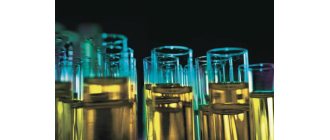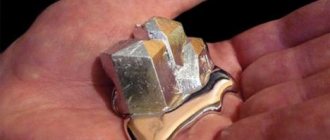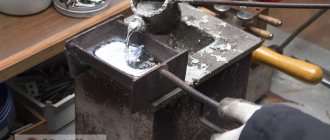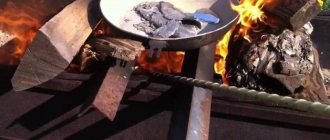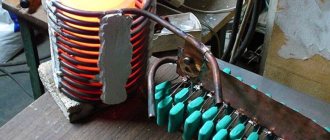Lead occupies number 82 in D.I. Mendeleev’s periodic table. It is a silvery, malleable metal that has a silvery tint. Many people who held this material in their hands noted its high specific gravity. Lead has a low melting point and is therefore easy to process.
Melting lead in production
Historical information
The chemical element has been known to people since ancient times. One of the first methods of metal extraction mastered by man was the smelting of lead. The first archaeological finds confirming this were lead beads found from the times of Çatalhöyük (modern Turkey). The items date back to 6400 BC.
The oldest lead figurine of a girl in long clothes was excavated in Egypt. It dates back to the time of the first dynasty of the pharaohs (3000 BC).
Lead pipes made up the ancient Roman water supply system. In the Ancient Roman Empire, up to 80 thousand tons of this metal were smelted annually. In Rus', since ancient times, lead has been used as roofing for cathedrals and churches.
Since time immemorial, the low melting point of lead has made it possible to obtain the metal and manufacture products of any shape from it.
Note! Over the course of 20 years, the Industrial Revolution since 1840 has raised the volume of annual lead smelting in the world from 100 to 250 thousand tons per year.
Which metal has the highest melting point
Tungsten is the most refractory metal, 3422 °C (6170 °F).
A hard, refractory, fairly heavy material of light gray color that has a metallic sheen. It is difficult to machine. At room temperature it is quite fragile and breaks. The fragility of the metal is associated with contamination with carbon and oxygen impurities.
Tungsten can be obtained from its ore, through complex chemical processing, as a powder. Using pressing and sintering, it is used to create parts of regular shape and bars.
Tungsten is an extremely resistant element to any temperature influences. For this reason, tungsten could not be softened for more than a hundred years. There was no furnace that could heat up to several thousand degrees Celsius. Scientists have been able to prove that this is the most refractory metal. Although there is an opinion that seaborgium, according to some theoretical data, has greater refractoriness, this is only an assumption, since it is a radioactive element and has a short lifespan.
Being in nature
Soldering aluminum
Plumbum is usually not found in its pure form. It is found in more than 100 different minerals in the form of intermetallic agglomerates. Lead is present in uranium and thorium veins. Large accumulations of lead-zinc ores have been discovered and are being developed in Transbaikalia and the Primorsky region. Lead is mined in various deposits in the Urals and Norilsk.
The largest deposit with a high content of lead is located in the uranium ores of the Kohistan Ladakh arc (northern Pakistan).
Fossil lead
ORIGIN
It forms impregnations in igneous, mainly acidic rocks; in deposits of Fe and Mn it is associated with magnetite and hausmannite.
Found in placers with native Au, Pt, Os, Ir. Under natural conditions, it often forms large deposits of lead-zinc or polymetallic ores of the stratiform type (Kholodninskoye, Transbaikalia), as well as skarn (Dalnegorskoye (formerly Tetyukhinskoye), Primorye; Broken Hill in Australia) type; galena is often found in deposits of other metals: pyrite-polymetallic (Southern and Middle Urals), copper-nickel (Norilsk), uranium (Kazakhstan), gold ore, etc. Sulfosalts are usually found in low-temperature hydrothermal deposits with antimony, arsenic, and also in gold deposits (Darasun, Transbaikalia). Lead minerals of the sulfide type have a hydrothermal genesis, minerals of the oxide type are common in weathering crusts (oxidation zones) of lead-zinc deposits. Lead is present in clarke concentrations in almost all rocks. The only place on earth where rocks contain more lead than uranium is the Kohistan-Ladakh arc in northern Pakistan.
Read also: Sip 7 110 kV technical characteristics
Receipt
How to solder a wire without a soldering iron
The raw materials for lead extraction are rocks that include helenite. The heavy metal smelting process consists of several phases. From the initial raw material, a concentrate containing from 40 to 70 percent plumbum is isolated by flotation. Next, manufacturers take different paths.
One of the ways to transform the product into werkbley (blank lead) is smelting using the regeneration method. Another method is that the metal is restored from the oxide by melting the raw material in a water jacket heater.
The resulting werkley containing 90% lead is purified from copper. Then arsenic and antimony are removed by alkaline refining. Then silver and zinc are isolated. The effects of magnesium and calcium exclude bismuth. As a result, lead with a purity of 99.8% is obtained.
Global lead production based on research by international organizations for 2005
| Manufacturer country | Volume, kilotons |
| Countries of Europe | 2220 |
| China | 1430 |
| Russian Federation | 1120 |
| South Korea | 650 |
| Kazakhstan | 570 |
| Ukraine | 410 |
Lead atom and molecule. Lead formula. Lead structure:
Lead (lat. Plumbum) is a chemical element of the periodic system of chemical elements of D.I. Mendeleev with the designation Pb and atomic number 82. It is located in the 14th group (according to the old classification - the main subgroup of the fourth group), the sixth period of the periodic system.
Lead is one of the heavy chemical elements in D.I. Mendeleev’s periodic table of chemical elements and belongs to the group of heavy metals.
Lead is a metal.
Lead is represented by the symbol Pb.
As a simple substance, lead under normal conditions is a malleable, relatively fusible heavy metal of a silvery-white color with a bluish tint.
The lead molecule is monoatomic.
The chemical formula of lead is Pb.
The electronic configuration of the lead atom is 1s2 2s2 2p6 3s2 3p6 3d10 4s2 4p6 4d10 4f14 5s2 5p6 5d10 6s2 6p2. The ionization potential (first electron) of the lead atom is 715.6 kJ/mol (7.4166799(6) eV).
The structure of the lead atom. The lead atom consists of a positively charged nucleus (+82), around which 82 electrons move through six atomic shells. In this case, 78 electrons are in the internal level, and 4 electrons are in the external level. Since lead is located in the sixth period, there are only six shells. First, the inner shell is represented by the s-orbital. The second – the inner shell is represented by s- and p-orbitals. The third and fifth – inner shells are represented by s-, p- and d-orbitals. The fourth - the inner shell is represented by s-, p-, d- and f-orbitals. Sixth - the outer shell is represented by s- and p-orbitals. At the outer energy level of the lead atom there are two paired electrons in the s orbital and two unpaired electrons in the p orbital. Therefore, lead exhibits valency II and IV and oxidation states +2 and +4. In turn, the nucleus of a lead atom consists of 82 protons and 125 neutrons. Lead belongs to the elements of the p-family.
The radius of the lead atom (calculated) is 154 pm.
The atomic mass a lead atom is 207.2(1) a. eat.
Lead is the last chemical element in D.I. Mendeleev’s periodic table of chemical elements, which has stable isotopes; chemical elements after lead do not have stable isotopes.
Lead, atomic properties, chemical and physical properties
Technological properties and characteristics
The characteristics of the metal can be represented by the list:
- Lead density and mass;
- Lead smelting temperature;
- Mechanical properties;
- Corrosion resistance.
Lead density and mass
The density of the metal is 11342 kg/m3. This means that a metric cube of lead weighs 11.342 tons. Its large specific gravity allows it to be used as payloads in various devices.
Lead smelting temperature
Molten metal in its pure form has a temperature of about 400 degrees. In this state, lead has fluid properties. The casting qualities make it possible to pour lead in a liquid state into molds of complex configurations.
Pouring a mold with lead
The metal boils when heated to 1750 degrees. During boiling, volatile fumes arise in the form of lead dust and oxide vapors, which can cause severe poisoning to the human body.
Mechanical properties
The chemical element has softness and ductility, which allows cold rolling to achieve the state of thin foil. Cold deformation does not affect the change in mechanical properties.
Corrosion resistance
The chemical inertness of the element is close to that of noble metals. In the air, plumbum practically does not corrode. The rapidly forming oxide film on the surface of lead puts an insurmountable barrier to corrosion processes.
Aggressive environments for lead are hydrogen sulfide, coal anhydrite and sulfuric acid. Under their influence, the metal is actively destroyed.
Safety precautions
Molten lead can cause significant injuries and burns. The drop will instantly burn through the clothing and land on the exposed skin. The liquid form of lead can leak onto flammable objects and cause a fire in the room. If water penetrates into the liquid melt, a sharp flash occurs with the spread of small splashes of metal over the entire area. Such inclusions can get on the skin and eyes, which is painful and dangerous for human organs. Thus, while working, it is imperative to use clothing that covers the entire body, including sleeves, and wear a hat. The fabric must be highly fire-resistant and heat-resistant. You must wear a mask and safety glasses on your face.
The room in which smelting is carried out must be well ventilated, due to the toxicity of lead evaporation. If a mask is not available, use a cotton-gauze bandage. If lead enters the body, it can provoke and aggravate a number of painful processes, accumulating in organs, the element causes acute poisoning.
Application areas of lead alloys
Lead compounds are divided into high-alloy and low-alloy alloys. The former are formed by adding a large number of chemical elements that provide high strength, abrasion resistance and low shrinkage at a lower melting point.
Low alloy lead compounds are produced by small inclusions of substances such as tin, antimony, copper and cadmium. This achieves increased resistance of the alloy to corrosion processes in a polluted atmosphere, inorganic acidic environment.
The alloys are used in acid and alkaline batteries, as shells for both high-power and low-voltage cables. Compounds of antimony or copper with lead are used for the production of pipelines, sheet lining of various devices and protective mats against radiation damage.
Tin Characteristics
Melts at 232 °C, boils at 2600 °C, perfectly alloys with various metals, and, due to its high ductility, can be forged well. Soldering tin is used as solder because it wets metals well. Industrial production of tin is much more difficult than lead, so it is much more expensive.
Unlike lead, tin looks much more attractive. This silvery-white metal is safe for human health. Tin is often used to cover the surfaces of metal products in places where they come into contact with food: dishes, tin plates, food foil and others. However, tin dust and fumes can cause hazardous effects on the human body if inhaled. In addition to the production of food containers, tin is widely used in various solders and other alloys, for example, in antifriction and bearing alloys. This material is much lighter than lead, its density is 7.3 g/cc.
https://youtube.com/watch?v=I33GCWrUJFE
Tin is polymorphic, meaning it can exist in various modifications depending on temperature. At temperatures below 13 °C, white tin (β-modification) turns into gray tin (α-modification). As a result of this phase transition, the shiny pewter pieces crumble into a gray powder. Moreover, upon contact with the powder, white tin becomes infected with it and turns into gray. This phenomenon is called the “tin plague.”
According to some reports, it was the main reason for the death of Robert Scott's expedition to the South Pole. Kerosene, stored in intermediate warehouses, leaked from canisters sealed at the seams with tin, which crumbled into powder in the frosts of the Antarctic. Thus, the expedition members were left almost without fuel.
Home and industrial methods
Without tin-lead solders (PLS), the existence of such an industry as radio engineering is impossible. Many industrial products contain POS coatings.
Tin-lead solders
The industry supplies the market with solder product:
- cast pigs;
- wire;
- foil tape;
- solder tubes with flux;
- powder or paste.
Alloys containing 90% tin and 10% lead are used for soldering products, which are then electroplated with gold or silver. The melting point of pure tin is 2310 C. Therefore, the solder will melt when heated to 2200 C.
Tubular solder with flux
Tin-lead POS with a predominance of tin in its composition (61%) has a lower melting point - 191%. POS 61 is used to cover contact groups in various devices; it is also used to process thin wire for windings of electric motor armatures and transformer coils.
Important! Taking into account the temperature at which tin melts, the % lead content in the alloy is regulated. This achieves a comfortable temperature regime, at which the tin-lead solder quickly turns into a liquid state.
POS 30 melts at 256 degrees. The compounds are less durable than products with a higher tin content.
10 percent solder is far from the temperature threshold at which tin melts. Therefore, POS 10 is used as a durable material for tinning large metal surfaces.
Melt preparation and pouring
In industrial conditions, the melt is prepared in special crucibles, which are placed in electric furnaces (equipment equipped with electronic measuring equipment that maintains the desired melting mode).
In radio engineering production, special heating baths are used to prepare solder for printed circuit boards of radio circuits.
In workshops and at home, solder is melted with a soldering iron tip. To prepare a large volume of molten metal, it is placed in a copper vessel on an electric stove. The alloy in the form of scrap is loaded into the melting bath gradually, as the next layer of metal melts.
Fishing varnishes
Avid fishermen at home cast fishing sinkers and spoons by pouring molten tin into clay molds. The spoons are then coated with waterproof varnishes.
Interesting. Fishing varnish is used to protect against the appearance of oxides on various figurines and other products.
Fishing varnish
Preparing to smelt lead
First you need to find a container. It would be great if the handle of the vessel was made of some heat-resistant material. For this purpose, you can use an old coffee pot or kettle.
The material can also be melted in an outdated container made of cast iron, using a deep and long spoon for pouring .
If there is no suitable container nearby, then you can use an ordinary tin can. However, here you should use pliers , which will be used to remove the hot pan from the flame and pour the material into the mold.
Do not forget that you need to be extremely careful while working. To simplify the procedure, you can make a small groove . In this case, the red-hot metal will pour out in a thin stream clearly into the required place.
The material, cleared of impurities, can be crushed so that it melts as quickly as possible. The container must be securely placed over the burner and heated properly . This must be done in order to rid the surface of excess impurities and moisture.
Melting procedure
There is no need to try to melt all the prepared lead at once, because only the very bottom layer will interact with the hot surface of the container.
First melt two or three pieces to form a puddle, then gradually add new material . This will give you the opportunity to make your work area more voluminous.
After melting, a layer of debris, impurities and slag must be removed . Pouring must be done into a heated mold. Lead is also characterized by rapid solidification. The material quickly loses its fluidity, becomes thicker, and therefore cannot completely fill the mold.
Methods for getting rid of oxide
When exposed to air, lead products become covered with an oxide film. This is the result of the ionic interaction of oxygen and lead atoms. The oxide becomes not only protection against an aggressive environment, but also a barrier to electric current.
Important! Mechanical cleaning will not bring the desired result. The film will recover quite quickly. Sunflower oil, graphite grease or varnish can help get rid of oxides.
At home, the product is placed in a vessel with sunflower oil for about five minutes. After which it is removed from the vessel and allowed to dry.
In industrial conditions, graphite lubricant is used. The lead surface treated with the product retains its shiny appearance for a long time.
Chemical properties
| This section is not completed. You will help the project by correcting and expanding it. |
Electronic formula: 5s25p65d106s26p2, ionization energy (Pb → Pb+ + e−) is 7.42 eV. There are 4 unpaired electrons on the outer electron shell (2 on the p- and 2 on the d-sublevels), therefore the main oxidation states of the lead atom are +2 and +4.
Salts of divalent lead react with alkalis, forming almost insoluble lead hydroxide:
P b 2 + + 2 OH − = P b ( OH ) 2 {\displaystyle \mathrm {Pb^{2+}} +\mathrm {2OH^{-}} =\mathrm {Pb(OH)_{2} } }
If there is an excess of alkali, the hydroxide dissolves:
P b ( OH ) 2 + 2 OH − = 2 − {\displaystyle \mathrm {Pb(OH)_{2}+2OH^{-}=^{2-}} }
Reacts with alkalis and acids:
The disproportionation reaction between PbO2 and Pb underlies the operation of lead batteries.
Lead crystal lattice:
| 500 | Crystal cell | |
| 511 | Crystal grid #1 | |
| 512 | Lattice structure | Cubic face centered |
| 513 | Lattice parameters | 4.950 Å |
| 514 | c/a ratio | |
| 515 | Debye temperature | 88K |
| 516 | Name of space symmetry group | Fm_3m |
| 517 | Symmetry space group number | 225 |

